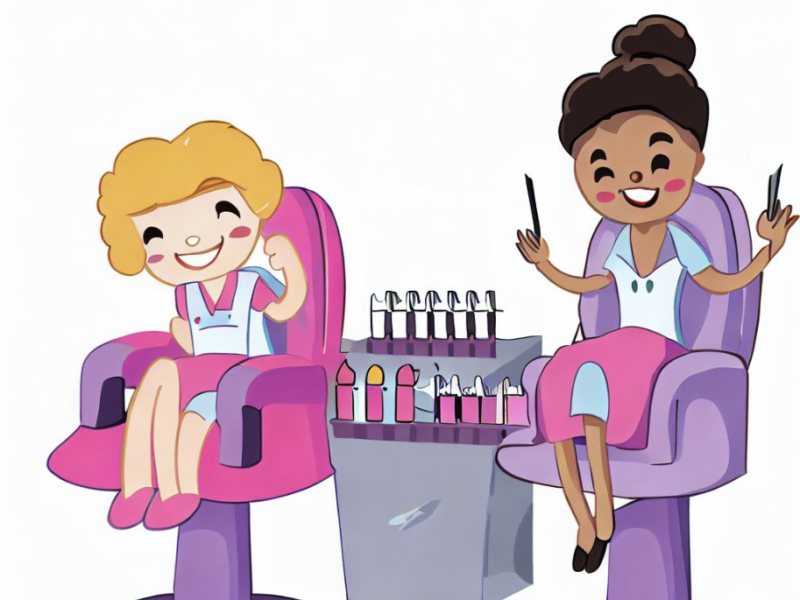The application of nail primer and dehydrator are two critical steps in the nail preparation process.
Both products serve unique purposes and are essential in their own right.
But what exactly are the differences between them, and how should they be used effectively?
Understanding Nail Dehydrator
What is a Nail Dehydrator?
A nail dehydrator is a solution that is used to remove oils and moisture from the nail plate before any product application.
The nail surface naturally contains oils that can hinder the adhesion of nail enhancements, such as acrylics, gels, or nail polish.
By eliminating these oils and creating a clean, dry surface, the dehydrator ensures that the applied products adhere properly and last longer.
When and How to Use Nail Dehydrator
Typically, a nail dehydrator is used after the nail has been cleaned and filed, and before the application of a nail primer or any nail enhancement.
It is applied in a thin layer over the natural nail and allowed to air dry for a few moments.
It’s crucial to avoid touching the nail after the dehydrator has been applied to prevent reintroducing oils from the skin.
Unlocking the Role of Nail Primer
Defining Nail Primer
Nail primer serves as a bonding agent between the natural nail and artificial nail products.
It enhances the adhesion of acrylics, gels, and other nail enhancements, ensuring that they remain chip-free and intact for an extended period.
Primers can be acid-based or acid-free, with the latter being a gentler option suitable for individuals with sensitive nails.
The Application Process of Nail Primer
Once the nail dehydrator has been applied and has fully dried, the nail primer is applied sparingly to the natural nail.
It’s essential to ensure that the primer does not come into contact with the skin, as some formulations can be irritating.
After applying the primer, it’s generally recommended to wait for it to dry before proceeding with the application of nail enhancements.
Nail Primer or Dehydrator First?
Always apply the nail dehydrator first.
The dehydrator removes oils and creates a clean, dry surface.
Once the dehydrator has fully dried, apply the nail primer to enhance the adhesion of the nail enhancements.
Nail Primer vs. Dehydrator: A Complementary Duo
Working Hand in Hand
While nail primer and dehydrator serve different purposes, they are not mutually exclusive in the nail preparation process.
In fact, they work best when used together.
The dehydrator first removes unwanted oils and moisture, creating an optimal surface for the primer to then enhance the adhesion of nail enhancements.
Why Both Are Essential
Skipping either the dehydrator or the primer can compromise the longevity and quality of the nail enhancement.
Without a dehydrator, oils on the nail surface can prevent the primer and subsequent products from adhering properly.
Conversely, without a primer, the nail enhancements may not form a strong bond with the natural nail, leading to premature lifting or peeling.
FAQs – Nail Primer vs. Dehydrator
What is the primary purpose of a nail dehydrator in nail artistry?
The primary purpose of a nail dehydrator is to eliminate oils and moisture from the natural nail plate, ensuring a clean and dry surface.
This step is crucial to prevent lifting, peeling, or chipping of nail enhancements by providing an optimal surface for adhesion.
How does a nail primer contribute to the longevity of nail enhancements?
Nail primer acts as a bonding agent between the natural nail and the applied nail enhancements, such as acrylics, gels, or polishes.
It enhances adhesion, ensuring that the enhancements adhere securely to the natural nail, thereby reducing the likelihood of lifting and increasing the longevity of the application.
Can nail primer and dehydrator be used interchangeably?
No, nail primer and dehydrator cannot be used interchangeably as they serve different purposes.
The dehydrator removes oils and moisture from the nail, while the primer ensures optimal adhesion of nail enhancements.
Both are essential and are used sequentially in the nail preparation process.
Is it necessary to use both a nail dehydrator and primer for all types of nail enhancements?
While it might not be strictly necessary for all types of nail enhancements, using both a nail dehydrator and primer is generally recommended to ensure optimal adhesion and longevity of the application.
Especially for enhancements like acrylics and gels, both products ensure that the natural nail is in the best possible condition to bond with the applied product.
What is the difference between acid-based and acid-free nail primers?
Acid-based primers contain methacrylic acid, which provides excellent adhesion but can be harsh and potentially damaging to the natural nail.
Acid-free primers, on the other hand, are generally gentler and are suitable for individuals with sensitive or fragile nails, although they might not provide as strong adhesion as acid-based primers.
Can I skip using a nail dehydrator if I have naturally dry nails?
Even if you have naturally dry nails, using a nail dehydrator is still recommended to ensure that all natural oils are removed.
This step ensures that you have the cleanest and most optimal surface for the nail enhancements to adhere to, minimizing the risk of lifting or peeling.
How should I apply a nail dehydrator and primer properly?
First, apply a thin layer of nail dehydrator to the clean, filed natural nail and allow it to air dry.
Avoid touching the nail afterward to prevent reintroducing oils.
Once the dehydrator has dried, apply a small amount of nail primer to the nail, ensuring it does not come into contact with the skin, and allow it to dry before proceeding with the application of nail enhancements.
Are there any potential side effects or risks associated with using nail primers?
Yes, particularly with acid-based primers, there can be risks of irritation, allergic reactions, or damage to the natural nail if used improperly.
Always follow the manufacturer’s instructions, avoid contact with the skin, and use in a well-ventilated area.
If you experience any adverse reactions, discontinue use and consult a professional.
Can nail dehydrator and primer be used with natural nail polish?
While dehydrator and primer are most commonly used with enhancements like acrylics and gels, they can also be used under regular nail polish to enhance adhesion and prolong wear.
Ensure that both products are fully dry before applying polish.
How do I choose the best nail primer and dehydrator for my nail type?
Choosing the best products involves considering your nail type and any sensitivities.
For sensitive or fragile nails, opt for an acid-free primer.
Read product reviews and perhaps consult with a nail professional to get recommendations based on your specific needs and the type of enhancements you plan to use.
What should I do if the nail primer comes into contact with my skin?
If nail primer comes into contact with your skin, it’s crucial to wash the area immediately with soap and water to prevent potential irritation or allergic reactions.
If you experience persistent redness, swelling, or discomfort, seek medical advice.
Always aim to apply the primer carefully to avoid skin contact and consider using a brush for precise application.
Can I use a nail primer or dehydrator on damaged or weakened nails?
Using a nail primer or dehydrator on damaged or weakened nails should be approached with caution.
While it’s possible to apply these products, it’s essential to ensure the nails are not further compromised. If the nails are significantly damaged, it may be best to allow them to heal before applying any enhancements.
Consulting a nail professional for advice on suitable products and treatments for damaged nails is also recommended.
How do I fix nail enhancements that lift or peel after application?
To fix lifted or peeled nail enhancements, gently file the lifted area and remove any loose edges.
Ensure the natural nail underneath is clean and dry. You may reapply a dehydrator and primer to the affected area before filling in with the appropriate enhancement product (gel, acrylic, etc.).
Cure or allow it to dry thoroughly, ensuring the repaired area is smooth and even with the rest of the nail.
Are there any alternative products to nail dehydrators and primers?
While nail dehydrators and primers are specifically formulated for enhancing adhesion of nail products, some technicians might use alternative products in a pinch.
For instance, some might use rubbing alcohol as a substitute for a dehydrator.
However, specialized nail dehydrators and primers are formulated to provide optimal results and are generally recommended for best outcomes.
How long should I wait between applying the dehydrator, primer, and nail enhancements?
After applying the nail dehydrator, wait until it is completely dry—usually a few moments—before applying the primer.
Once the primer is applied, again wait for it to dry thoroughly before proceeding with the nail enhancements.
The drying time can depend on the specific products used, so always follow the manufacturer’s instructions.
What are the best brands for nail primers and dehydrators in the market?
Several brands are renowned for their nail primers and dehydrators, such as OPI, CND, Young Nails, and Mia Secret.
The “best” brand can depend on personal preference, nail type, and the specific requirements of the nail enhancements being used.
Reading reviews and seeking recommendations from nail professionals can help determine which brand might be best for you.
Can I create nail art without using a primer and dehydrator?
Yes, you can create nail art without using a primer and dehydrator, especially if you’re working with regular nail polish.
However, for nail enhancements like gels or acrylics, skipping these steps may compromise the longevity and quality of the application, leading to potential lifting or peeling.
How do I remove nail enhancements applied with primer without damaging my natural nails?
To remove nail enhancements without damaging the natural nails, it’s crucial to avoid forcefully peeling or chipping them off.
For acrylics, soak the nails in acetone until the enhancement softens and can be gently removed.
For gels, file off the top layer and then soak in acetone.
Always proceed gently and patiently to minimize damage to the natural nail.
Is it safe to use a nail dehydrator and primer frequently?
Using a nail dehydrator and primer is generally safe when used correctly and in accordance with manufacturer guidelines.
However, frequent use of nail enhancements, which require repeated application of these products, can potentially lead to weakened or dried out natural nails over time.
Ensuring you follow best practices for nail care and occasionally giving your nails a break from enhancements can help maintain their health.
How can I ensure maximum adhesion of nail enhancements when using a primer and dehydrator?
To ensure maximum adhesion:
- Always start with clean, properly filed nails.
- Apply the dehydrator and allow it to fully dry to ensure all oils are removed.
- Apply the primer carefully, avoiding the skin, and allow it to dry thoroughly.
- Follow with the appropriate nail enhancement, ensuring it is applied evenly and cured (if necessary) per product instructions.
- Ensure all tools and products are in good condition and free from contaminants.
Conclusion – Nail Primer vs. Dehydrator
In nail art and enhancements, the preparation of the natural nail is just as crucial as the application of colors and designs.
By understanding and effectively utilizing both nail dehydrator and primer, nail technicians and enthusiasts alike can ensure that every nail application is set upon a foundation that is robust, durable, and primed for perfection.
This meticulous approach to nail preparation not only enhances the beauty of the nails but also safeguards the health and integrity of the natural nail underneath.


